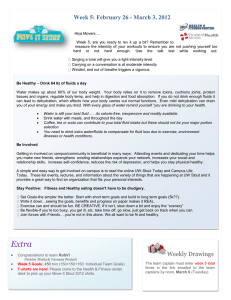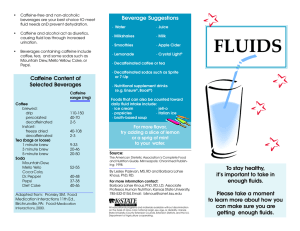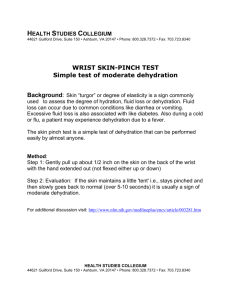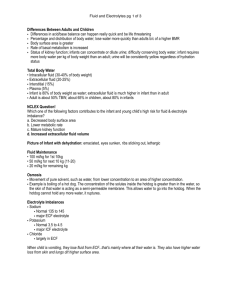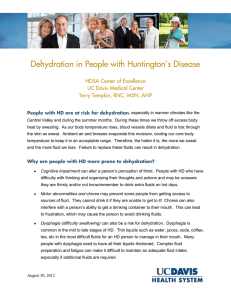Water • Inorganic • Not energy-yielding • Essential
advertisement
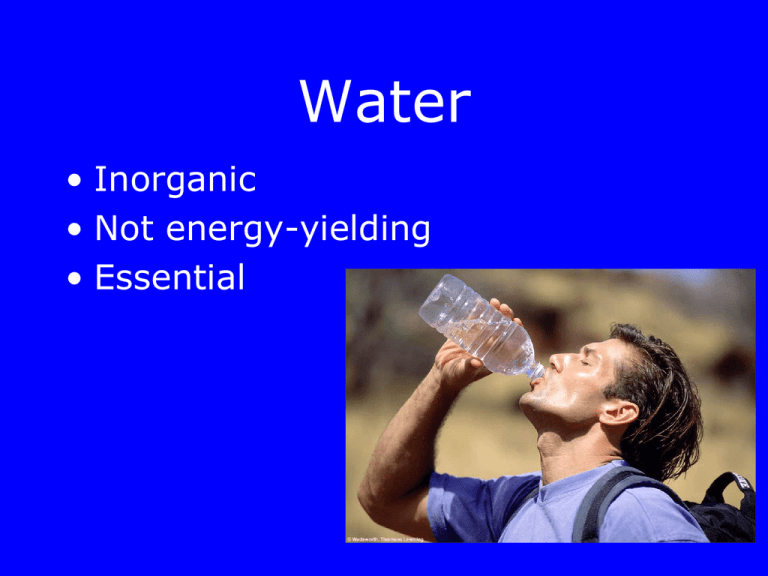
Water • Inorganic • Not energy-yielding • Essential Objectives • After reading Chapter 7 and class discussion, you will be able to: –Define terms associated with water and body fluids –Describe the fluid composition of the body –Describe water balance Objectives • Identify sources of water and % of water in selected foods • Discuss symptoms of dehydration • Apply oral rehydration therapy (ORT) • Describe functions of water Functions of Water • Transport • Solvent • Lubricant • Maintain blood volume • Body temperature regulation • Structural support for molecules • Participate in metabolic reactions Functions of Water • Transport –Carries nutrients to the cells and carries away waste materials to the kidneys and out of the body in urine Functions of Water • Solvent –Keeps the following in solution so they can participate in metabolic activities: •Minerals •Vitamins •Glucose •Many other small molecules in the body Functions of Water • Lubricant –Acts as a lubricant or cushion around joints; in the eye, the spinal cord –In pregnancy cushions the amniotic sac surrounding the fetus Functions of Water • Maintains blood volume • Body temperature regulation –evaporation of sweat from the skim removes excess heat from the body Functions of Water • Structural support –Maintains the structure of large molecules such as protein and glycogen • Metabolic reactions –Water participates in every step of the process of converting food to energy and tissue Body Composition 60% Water in the Body • Nutrient composition of the body –Water = 60% –Fat = 13-31% •Male = 13 -21% •Female = 23 -31% –Carbohydrate, Protein, Vitamins, Minerals, Other = 9 – 27% Water in the Body • Example: 150# body –Water = 90# –Fat = 20 -45# –Carbohydrate, Protein, Major Minerals = 15 -40# –Vitamin, Minor Minerals = < 1# Water In The Body • Adult body composition is 60% water; higher in children • Water is ¾ of weight of lean tissue • Water is ¼ of weight of fat tissue • Proportion of water smaller in women, obese, and elderly Body Fluids • Intracellular • Extracellular – Interstitial – Intravascular Water In = Water Out Water Balance • Water losses – Obligatory losses=500cc/day (2 c.) • Needed to dispose of body wastes – Insensible losses – lungs, skin • Water sources •Food sources (700-1000 cc) •Liquid sources – Water vs. Liquids Fluid:Nutrient Comparison Fluid Free Water (cc) Calories/Protein Water 240 cc (100%) 0/0 Juice (Apple) 210 cc (88%) 111/0 Whole Milk 214 cc (89%) 150/8 Instant Breakfast 217 cc (80%) 250/13 Fruit Beverage Supplement 191 cc (79%) 300/10 How Much Water is Enough? Recommended Water Intake • 1 cc/kcal (30-35 cc/kg) • 6-10 cups per day • Adequate Intake (AI): • Men=3.7 L/day (about 14 c/day) • Women=2.7 L/day (about 10 c/day) Water Balance • Dehydration – See Signs of Dehydration – Treat with Oral Rehydration Therapy • Water Intoxication – Hyponatremia – Athletes – Elderly Fluid And Electrolyte Imbalance • Replacing lost fluids/electrolytes – Oral rehydration therapy (ORT) • ½ L. boiling water • 4 t. sugar • ½ t. salt Coffee vs. Water • What about coffee/caffeine? • No significant difference in hydration • Caffeine naivety Journal of American College of Nutrition 2000, 2003 For Caffeine Users Objectives • After reading Chapter 7 and class discussion, you will be able to: – Define terms associated with water and body fluids – Describe the fluid composition of the body – Describe water balance – Identify sources of water and % of water in selected foods Objectives • Discuss symptoms of dehydration • Apply oral rehydration therapy (ORT) • Describe functions of water
